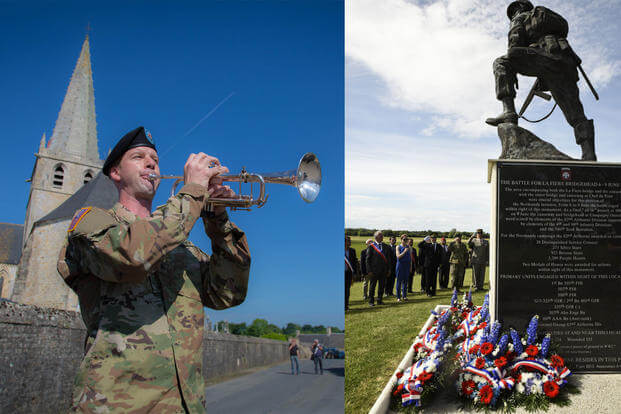They parachuted behind enemy lines hours before D-Day, landing in high-risk enemy territory and fighting off Nazi troops to secure bridges and roadways for Allied invading forces.
The 101st and 82nd Airborne Divisions, who earned fame for their contributions to D-Day, took on an assignment knowing there would be heavy casualties – all for the Allied WWII Normandy invasion.
“The 82nd and 101st fought pockets of German defenses to keep roads and bridges open,” Elizabeth Coble, Command Historian XVIIIth Airborne Corps, Fort Bragg, N.C., told Military.com in an interview.
Paratroopers were air-dropped from C-47 aircraft and others landed with “glider” aircraft (soft-skinned aircraft without engines), all under heavy enemy fire. “Many aircraft were pulling Gliders, when they got close to their objective, the pilots cut the rope and troops landed in a flat clear field,” Coble said. The gliders carried troops, artillery pieces, ammunition and other heavy equipment.
Airborne forces started dropping just hours before the larger D-Day invasion, which began on June 6, 1944. The landings took place at around 7AM. However, German forces were ready to attack landing forces and heavy fire destroyed some of the arriving aircraft.
Overall, 2,303 members of the 101st were wounded and 868 were killed. “Many guys were killed because the planes were shot down before they got to their objective – anti-aircraft fire was so heavy,” said Coble.
Not As Planned
Despite the mission’s ultimate success, things did not go as planned. Airborne forces, which flew East over the Contentin Peninsula toward Utah and Omaha Beach, did not land at the intended objective. Many troops wound up landing in marshy areas between Utah and Omaha Beach -- 20 miles away from the objective in some cases. Coble explained that the arriving aircraft got jumbled up, and members of the 101st wound up landing on top of each other.
“They accomplished their objectives in a manner different than they expected,” she said. “Pilots were scared flying through all the anti-aircraft fire. They did not slow down to let the paratroopers out. Many guys had equipment ripped off before they jumped. Some guys did not have anything when they landed. They were scavenging for themselves seeking food and ammo.”
U.S. forces also had difficulty advancing upon landing. The Germans had flooded fields and waterways, and used natural dirt and tree fences as obstacles, along with hundreds of acres of mine fields. “Much of the land was covered with water. There were paratroopers that drowned because they were carrying so much weight. Their equipment pulled them down,” Coble said.
Today at St. Mere Eglise in France, a monument known as “Iron Mike” stands, honoring the sacrifices that the 101st Airborne and 82nd Airborne made on that day, along with other allies. The memorial site is located near the La Fiere Bridge, where an intense battle took place from June 6-9, 1944, with 254 Allied casualties and 525 wounded.
The small bridge over the Merderet River served as a strategic point for the Americans to expand their beachhead in Normandy, and where airborne forces made their stand against the Germans. Despite being relatively light on weapons, they managed to withstand enemy fire and hold the bridge, in an action that has come to symbolize their tenacity on D-Day. Or as Gen. Curtis Scaparrotti, the Supreme Allied Commander Europe (NATO) and commander of U.S. European Command, put it during a D-Day commemoration in 2017: "Several hundred airborne warriors seized a causeway that helped free a continent and end a war."












